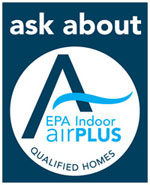A tight envelope may exacerbate indoor air quality problems, so what should you watch for?
By Fernando Pages Ruiz
Tightening a home’s building envelope can result in significant energy savings, but it can also choke off the air exchanged through the building shell, potentially contributing to the buildup of indoor air pollutants.
Improving IAQ requires a systems approach…The prescriptive directions of Indoor airPLUS focus on seven general categories: moisture control, radon mitigation, pest management, HVAC best practices with whole house ventilation, proper combustion venting, specifying building materials with reduced chemical off-gassing potential, and home commissioning… a balance between proper ventilation and source control.
In-The-Field Advice
The EPA’s Indoor airPLUS best practices include the following, as detailed in the EPA brochure “Step Up to Indoor airPLUS.”
• Build in added mold and moisture protection with water-managed roofs, walls, and foundations. “Features include continuous drainage planes, proper flashing and air sealing, damp-proof foundation walls, capillary breaks, drain tile, and proper grading.”
• Prevent pests by fully sealing, caulking, or screening likely entry points. Combining physical barriers with proper pest management techniques may reduce pesticide use.
• Employ “best-practice design and installation of ducts and equipment to minimize condensation problems, whole-house and spot ventilation to help dilute and exhaust indoor pollutants, and air filtration to remove airborne particulates.”
• Provide radon-resistant construction in potentially high-radon areas, “including gravel and plastic sheeting below slabs, fully sealed and caulked foundation penetrations, plastic vent pipe running from below slab through the roof, and an attic receptacle for easily adding an electric powered fan to the vent pipe if needed.”
• Reduce potential exposure to combustion gases by “installing direct- or power-vented gas- and oil-fired equipment, properly vented fireplaces, garages fully sealed from living spaces and equipped with an exhaust fan, and carbon monoxide alarms in each sleeping area.”
• Reduce sources of pollutants by selecting materials that minimize risk of moisture damage and have reduced chemical content, and ventilate a home prior to occupancy.
For more information, visit epa.gov/iaplus01/pdfs/builder_brochure.pdf.
